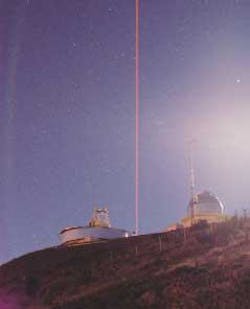
Scientists at the Air Force Research Laboratory (AFRL; Albuquerque, NM) have generated 20 W of continuous-wave (CW) laser power in a diffraction-limited and single-frequency yellow beam at 589.159 nm. When projected into the sky, the beam creates an artificial guidestar in the mesospheric sodium layer (at 90 km in altitude) through resonant D2a-line excitation. Large ground-based telescopes equipped with adaptive optics can use a sodium guidestar to measure atmospheric turbulence and remove distortions, enabling high-resolution ground-based astronomical observations and the propagation of concentrated high-power laser beams into space. The AFRL laser is one of several technologies being developed as an alternative to cumbersome pulsed dye-laser guidestar systems.
"This laser avoids flammable dye and is four times more power efficient than other existing laser guidestar systems," says Paul Hillman, optical engineer on the project. The laser requires a small 1-kW chiller, while dye-laser guidestar systems such as that at the Keck Observatory atop Hawaii's Mauna Kea require "a whole room full of chillers" (see Laser Focus World, March 2002, p. 28).
The system requires 300 W of electric wall-plug power to operate, and can be powered up from a cold start within 10 minutes. "That's quite an achievement," says Deanna Pennington of Lawrence Livermore National Laboratory (Livermore, CA), who is project leader for Guide Star Laser Systems, including the Mauna Kea system. The AFRL interest in developing such a powerful guidestar laser, however, extends beyond astronomy. The system is scalable to 50 W, enabling tracking of moving objects like satellites.
The laser was tested from Kirtland AFB, NM, on Nov. 21, 2002. Researchers from the High-Power Solid-State Laser branch directed the laser to an altitude of 89∞. The auxiliary beam director (ABD) used to steer the beam had flat 1.5-m-diameter mirrors coated at 1.3 µm. "Half of the beam power was lost because the telescope with the required accuracy had steering flats coated at 1.3 µm rather than the optimal 589 nm," says Hillman. "Even so, we projected 10.1 W on the sky."
The guidestar was observed with a 3.5-m-diameter reflecting telescope using two calibrated receivers, a photometric camera, and a photomultiplier tube. For linear 589-nm polarization, the spatially integrated extra-atmospheric (catalogued value) star magnitude in the V band was 7.1. This corresponds to a radiance of about 850 photons/cm2/s at the telescope primary mirror, closely agreeing with theory.
The collimated 10-cm-diameter beam projected a spot size (full width at half maximum) in the mesosphere of 4.3 × 17 arcsec. This corresponds to a spot 1.9 m wide and 13.3 km long from 90 km away. The spot appeared elongated because the observing telescope is 50 m from the ABD (see figure). The spot size and correlated resolution will improve with better collimation from focus adjustments on the telescope and beam expander, says Hillman.
The 589-nm excitation source was developed by adding the frequencies of two Nd:YAG infrared laser lines (1064- and 1319-nm wavelengths) within a doubly resonant optical cavity containing a crystal of lithium triborate (LBO) using the nonlinear optical process of sum-frequency generation (SFG). Nearly 60% optical-to-optical conversion efficiency was achieved. The infrared wavelengths were provided by two high-power CW single-frequency injection-locked ring lasers, one producing 24 W at 1064 nm and the other 15 W at 1319 nm, both with TEM00-mode operation (beam quality M2 = 1.05).
The sources were made simultaneously resonant with the external SFG cavity via separate phase-locked loop feedback circuits. The SFG takes place in the 20 × 5 × 5-mm LBO crystal. Noncritical type-I phase-matching occurs at a temperature of approximately 40°C. The 589-nm beam pointing stability is better than one-tenth of its diffraction-limited divergence.
Future plans are to build a 50-W system mounted on a 3.5-m telescope by the summer of 2004. The 1319- and 1060-nm injection-laser cavities will be "beefed up" with more amplifiers made by Lightwave Electronics (Mountain View, CA).
The international astronomy community is closely following the development of this laser. "The AFRL demonstration is the first of the high-power CW systems under development to go on the sky, and is a significant boost in previously demonstrated CW power," says Pennington. "This technology certainly bears watching."
REFERENCE
- J. C. Bienfang et al., post-deadline paper, OSA Adv. Solid-State Photon. Conf., (San Antonio, TX; 2003).
About the Author
Valerie Coffey-Rosich
Contributing Editor
Valerie Coffey-Rosich is a freelance science and technology writer and editor and a contributing editor for Laser Focus World; she previously served as an Associate Technical Editor (2000-2003) and a Senior Technical Editor (2007-2008) for Laser Focus World.
Valerie holds a BS in physics from the University of Nevada, Reno, and an MA in astronomy from Boston University. She specializes in editing and writing about optics, photonics, astronomy, and physics in academic, reference, and business-to-business publications. In addition to Laser Focus World, her work has appeared online and in print for clients such as the American Institute of Physics, American Heritage Dictionary, BioPhotonics, Encyclopedia Britannica, EuroPhotonics, the Optical Society of America, Photonics Focus, Photonics Spectra, Sky & Telescope, and many others. She is based in Palm Springs, California.
